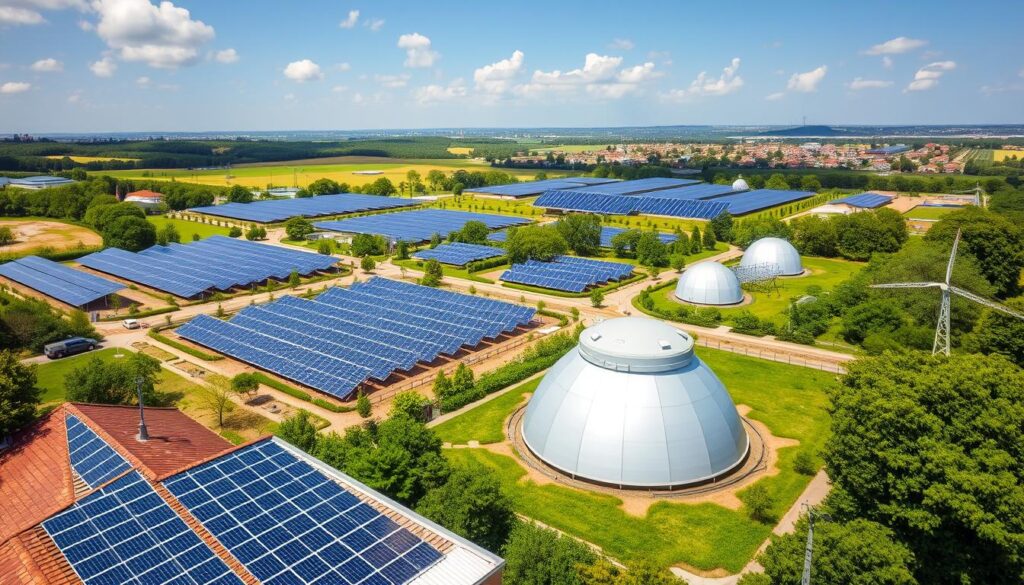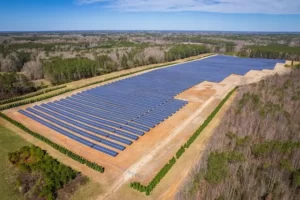Did you know that the sun’s core fuses about 620 million metric tons of hydrogen every second? This staggering amount of energy, generated by the sun, is the foundation of solar energy – a renewable resource that has the potential to meet all of humanity’s future energy needs. Solar energy refers to the radiation from the sun that can be captured and converted into useful forms of energy, such as heat and electricity. It is a clean, abundant, and increasingly accessible source of power that is transforming the way we think about energy production and consumption.
Key Takeaways
- Solar energy is the radiation from the sun that can be harnessed to produce heat, drive chemical reactions, and generate electricity.
- It is a renewable, non-polluting energy source with the potential to meet global energy demands.
- Solar energy can be converted into useful forms of energy through various technologies, including photovoltaic cells and solar thermal systems.
- The sun’s energy reaches the Earth in the form of visible light, infrared radiation, and smaller amounts of ultraviolet and other electromagnetic waves.
- Harnessing solar energy is a key strategy for transitioning to a more sustainable energy future.
Introduction to Solar Energy
Definition and Importance
Solar energy is a versatile and renewable energy source that harnesses the power of the sun. It is generated through the nuclear fusion process occurring in the sun’s core, where hydrogen atoms collide and fuse to create helium, releasing immense amounts of solar radiation. This solar radiation warms the Earth, drives the water cycle, and sustains life on our planet through photosynthesis.
The importance of solar energy cannot be overstated. As a renewable energy source, it offers a sustainable and environmentally friendly alternative to traditional fossil fuels, which are finite and contribute to greenhouse gas emissions. Solar energy has the potential to reduce our reliance on non-renewable resources, mitigate climate change, and promote energy independence.
Solar Energy as a Renewable Resource
Unlike fossil fuels, which are limited and will eventually be depleted, solar energy is a renewable energy source that can be harnessed indefinitely. The sun is expected to continue shining for another 5 billion years, making it a reliable and abundant source of energy for our planet.
The use of solar energy has steadily grown in recent years, with solar power systems being installed on both residential and commercial properties, as well as in large-scale solar farms. As technology advances and costs continue to decrease, the accessibility and adoption of solar energy are expected to increase, further highlighting its importance as a renewable energy source.
“The sun, with all those planets revolving around it and dependent on it, can still ripen a bunch of grapes as if it had nothing else in the universe to do.”
– Galileo Galilei
What is the Basic Definition of Solar Energy?
Solar energy is a renewable energy source derived from the sun’s radiant light and heat. It is created through nuclear fusion in the sun’s core, where hydrogen atoms fuse to form helium, releasing vast amounts of energy in the form of electromagnetic radiation. This solar radiation reaches Earth, where it participates in the greenhouse effect, warming the planet and enabling life.
Solar energy is considered a renewable energy source because the sun will continue to produce this radiation for billions of years to come. Unlike fossil fuels, which are finite, the sun’s energy is constantly replenished, making it an abundant and sustainable source of power.
Australia’s solar energy resources are particularly abundant in desert regions in the northwest and center of the continent, with the country receiving an average of 58 million petajoules (PJ) of solar radiation per year. However, solar energy currently accounts for only about 0.1 per cent of Australia’s total primary energy consumption.
“Solar energy is a key player in the transition to cleaner economies, attracting investment, creating jobs, and increasing competitiveness.”
As the world shifts towards more sustainable energy sources, the potential of solar energy to play a significant role in powering our homes, businesses, and communities is becoming increasingly clear. With the right policies and technological advancements, solar energy can become a more widely adopted and impactful renewable energy source in Australia and around the globe.
The Sun: A Powerful Energy Source
The sun is an extraordinarily powerful energy source, and sunlight is the largest source of energy received by Earth. However, the intensity of solar radiation reaching Earth’s surface is relatively low due to the enormous radial spreading of radiation from the distant sun and some absorption and scattering by the atmosphere and clouds. This solar radiation plays a critical role in Earth’s energy balance, driving natural processes like the water cycle and climate patterns through the greenhouse effect.
Solar Radiation and Earth’s Energy Balance
The amount of solar radiation that strikes the Earth’s surface in an hour and a half is enough to handle the entire world’s energy consumption for a full year. This sun’s energy drives the natural processes that maintain Earth’s energy balance, such as:
- Powering the water cycle through evaporation and precipitation
- Influencing climate patterns and weather systems
- Sustaining the greenhouse effect that regulates the planet’s temperature
The intensity of solar radiation received on Earth’s surface varies based on factors like geographic location, time of day, season, local landscape, and weather conditions. For example, cities like Denver, Colorado, near 40° latitude, receive nearly three times more solar energy in June compared to December.
Advances in technology, declining costs, and supportive government policies are driving the growth of solar energy as a crucial component of the global energy transition in the 21st century.
Harnessing Solar Energy
Solar energy is a vast and renewable resource that has the potential to meet the world’s growing energy needs. Harnessing this abundant source of power can be achieved through two primary approaches: active solar technologies and passive solar technologies.
Active Solar Technologies
Active solar technologies rely on electrical or mechanical devices to convert solar energy into usable forms of energy, such as electricity or heat. These technologies include photovoltaic cells, which convert sunlight directly into electricity, and solar thermal collectors, which absorb the sun’s heat to warm fluids or generate steam for various applications.
Photovoltaic cells, also known as solar cells, are the building blocks of solar panels and can be used on a small scale in homes and businesses or on a large scale in utility-scale solar power plants. Solar thermal collectors, on the other hand, are often used for water heating and space heating in residential and commercial buildings.
Passive Solar Technologies
Passive solar technologies, in contrast, harness solar energy without the use of external devices. These technologies take advantage of the local climate and building design to heat and cool structures naturally. Examples of passive solar technologies include strategic building orientation, proper window placement, and the use of thermal mass materials to store and distribute heat.
Passive solar architecture, which integrates these design principles, can significantly reduce the energy needs of a building and provide a comfortable indoor environment year-round. By leveraging the sun’s free and abundant energy, passive solar technologies offer an efficient and sustainable approach to meeting a building’s heating and cooling requirements.
| Active Solar Technologies | Passive Solar Technologies |
|---|---|
|
|
By harnessing both active and passive solar technologies, we can unlock the full potential of this renewable energy source and take a significant step towards a sustainable future.

“The sun, with all those planets revolving around it and dependent on it, can still ripen a bunch of grapes as if it had nothing else in the universe to do.”
– Galileo Galilei
Photovoltaic Technology
Photovoltaic technology is a revolutionary form of active solar technology that directly converts solar radiation into electricity. At the heart of this technology are semiconductor materials, typically silicon, which have the remarkable ability to absorb sunlight and generate an electric current. These photovoltaic arrays, consisting of interconnected solar panels and cells, have found widespread applications, from powering satellites and large-scale solar power plants to providing electricity for individual homes and small devices.
The development of photovoltaic technology traces back to 1954, when scientists at Bell Laboratories created the first silicon-based solar cell that could generate electric current when exposed to sunlight. Today, the majority of solar cells continue to be made from silicon due to its reasonable prices and good conversion efficiency.
Alongside traditional silicon-based solar cells, researchers are exploring various next-generation photovoltaic technologies, such as thin-film solar cells, III-V solar cells, organic materials, quantum dots, and hybrid materials. These innovative approaches aim to enhance the performance, reliability, and cost-effectiveness of solar energy harvesting.
| Solar Cell Technology | Efficiency Range | Characteristics |
|---|---|---|
| Monocrystalline Silicon | 20% – 22% | Highest efficiency among common solar cell types |
| Polycrystalline Silicon | 15% – 17% | Slightly lower efficiency but less expensive to manufacture |
| Thin-Film | 10% – 13% | Least expensive to produce but also lowest efficiency |
| III-V Compounds | 25% – 30% | Highest efficiency but costlier to manufacture |
As the photovoltaic industry continues to evolve, the focus has shifted to ensuring the reliability and integration of solar panels into the electric grid without destabilizing power supply and demand. Professionals at the National Renewable Energy Laboratory (NREL) are at the forefront of this research, addressing concerns such as performance degradation and grid integration.
The adoption of photovoltaic technology is steadily growing, with Australia being a prime example. The country receives thousands of times more solar energy from the sun each year than all its fossil fuel use combined. In 2012, about one gigawatt of solar power was installed in Australia, and nearly one million Australian houses now have photovoltaic systems on their roofs.
As the cost of solar photovoltaic modules and systems continues to decline, the technology is becoming increasingly accessible and cost-competitive with conventional electricity sources. This trend, coupled with advancements in solar cell efficiency and reliability, suggests a promising future for the widespread adoption of photovoltaic technology in both residential and utility-scale applications.
“The sun is the most abundant energy resource on Earth, and photovoltaic technology is poised to harness this renewable energy source for a sustainable future.”
Concentrated Solar Power
Concentrated solar power (CSP) is a captivating technology that harnesses the sun’s energy in an ingenious way. Unlike traditional photovoltaic solar panels, CSP systems use mirrors and lenses to concentrate the sun’s rays onto a small area, generating intense heat that can be used to power steam turbines and produce electricity. This innovative approach opens up a world of possibilities in the quest for renewable energy solutions.
Solar Power Towers and Parabolic Troughs
At the forefront of CSP technology are two remarkable systems: solar power towers and parabolic troughs. Solar power towers utilize a field of mirrors that reflect sunlight onto a central receiver tower, where the heat is captured and used to generate steam that drives a turbine. These systems can reach temperatures up to 600°C, making them highly efficient in electricity production.
Parabolic troughs, on the other hand, employ long, curved mirrors that focus sunlight onto a receiver tube running along the trough’s focal line. The heat absorbed by the fluid in the receiver tube is then used to generate steam and power a turbine. Parabolic trough systems have been the dominant CSP technology, accounting for over 90% of commercial CSP operations as of 2018.
These two CSP systems, along with other variations like Fresnel reflectors and solar furnaces, are steadily gaining ground in the renewable energy landscape. As of 2021, the global installed capacity of concentrated solar power reached 6.8 GW, with an additional 1.5 GW under construction. This growth is a testament to the potential of CSP technology to play a significant role in our transition to a sustainable energy future.
“Concentrated solar power plants are proving their worth, delivering reliable, dispatchable power and helping to drive down the cost of renewable energy.”
Solar Thermal Energy
Solar thermal energy is a remarkable technology that harnesses the sun’s power to generate heat. This versatile approach has a wide range of applications, from heating homes and water to powering industrial processes and even generating electricity through the organic Rankine cycle. At the heart of this technology are solar collectors, which come in various forms – from the familiar flat-plate collectors used for solar water heaters and solar heating systems, to the more advanced solar ponds that can store thermal energy for extended periods.
In the United States, heating, ventilation, and air conditioning (HVAC) systems account for over 25% (4.75 EJ) of the energy used in commercial buildings and nearly half (10.1 EJ) of the energy used in residential buildings. Solar thermal energy technologies offer a sustainable solution to reduce this significant energy demand, with the potential to offset a substantial portion of home heating needs.
Beyond residential applications, solar thermal energy is also making strides in the industrial and utility-scale sectors. For instance, in Europe, over 125 large solar-thermal district heating plants have been constructed since the mid-1990s, each with over 500 m2 (5,400 ft2) of solar collectors. These plants can provide cost-effective, clean thermal energy to entire communities, with solar heat costs around 4 Eurocents/kWh without subsidies.
The versatility of solar thermal energy is further demonstrated by the success of the Drake Landing Solar Community in Alberta, Canada, which achieved a world record in 2012 by providing 97% of the community’s all-year space heating needs from solar energy using seasonal thermal energy storage.
As the world continues to seek sustainable energy solutions, solar thermal energy stands out as a promising technology that can make a significant impact on our energy landscape. From residential water heating to industrial-scale power generation, this renewable resource is poised to play a crucial role in our transition to a cleaner, more efficient energy future.
Solar Energy Applications
The sun’s abundant and renewable energy has a wide range of practical applications, from small-scale residential and commercial uses to large-scale utility-level power generation. Solar energy is versatile, efficient, and environmentally friendly, making it an increasingly popular choice for powering homes, businesses, and communities around the world.
Residential and Commercial Uses
In the residential and commercial sectors, solar energy has become a common sight. Rooftop solar panels convert sunlight into electricity to power homes and businesses, reducing reliance on traditional grid-supplied power. Solar water heaters are another popular application, using the sun’s energy to heat water for domestic and commercial use. Additionally, smaller solar-powered devices, such as calculators, parking meters, and outdoor lighting, are becoming more prevalent in our daily lives.
Utility-Scale Solar Power Plants
At the utility scale, large-scale solar power plants, known as solar farms, can generate hundreds of megawatts of electricity to power entire communities and cities. These utility-scale solar power plants, like the Solar Energy Generating System (SEGS) in California, utilize advanced solar technologies, such as photovoltaic (PV) panels and concentrated solar power (CSP) systems, to harness the sun’s energy and feed it into the electrical grid.

Solar energy’s versatility and scalability make it a valuable asset in the global transition towards renewable and sustainable energy sources. As technology continues to advance and costs decrease, we can expect to see even more innovative solar energy applications emerge, further expanding the reach and impact of this clean, abundant resource.
Environmental Benefits of Solar Energy
Solar energy is a clean, renewable power source that offers significant environmental advantages compared to traditional fossil fuels. Unlike fossil fuel-based electricity generation, the use of solar energy does not produce any greenhouse gas emissions or other air pollutants, making it a valuable tool in the fight against climate change. Solar energy also helps preserve natural resources and reduces dependence on finite, non-renewable energy sources, contributing to a more sustainable energy future.
One of the primary environmental benefits of solar energy is its water conservation. Solar panels do not use any water to generate electricity, unlike traditional electricity production, which can consume thousands of liters of water annually. This helps alleviate the strain on water resources and conserves this valuable natural resource.
Furthermore, solar energy production results in zero harmful emissions, contributing to a reduction in air pollution compared to electricity generation from fossil fuels. Solar panels generate electricity without releasing any greenhouse gases, aiding in slowing down the effects of climate change by reducing the enhanced greenhouse effect.
Homeowners who switch to solar energy can significantly reduce their carbon footprint, potentially offsetting around half to one tonne of carbon dioxide for every megawatt-hour of solar energy used. With an abundance of free, clean energy from the sun, solar power reduces the reliance on finite fossil fuel resources, providing a cleaner and more stable energy future.
| Environmental Benefit | Impact |
|---|---|
| Zero water usage | Conserves water resources |
| Zero greenhouse gas emissions | Reduces air pollution and climate change impact |
| Renewable and abundant energy source | Reduces dependence on finite fossil fuels |
| Long lifespan of solar panels | Minimizes waste and resource consumption |
In conclusion, the environmental benefits of solar energy make it a crucial component in the transition to a more sustainable energy future. By harnessing the power of the sun, we can reduce our carbon footprint, conserve natural resources, and contribute to the fight against climate change.
Challenges and Future Outlook
While solar energy has significant advantages, it also faces some challenges that need to be addressed. The high initial cost of solar technology, such as photovoltaic panels and concentrated solar power systems, can be a barrier to widespread adoption. However, the costs of solar energy have been steadily declining due to technological advancements and increased production scale.
As the solar energy industry continues to innovate and improve the efficiency and affordability of solar technologies, the future outlook for solar energy remains promising, with the potential to play a growing role in the global energy mix. Researchers are exploring new materials, such as perovskite, to enhance the efficiency of solar panels, and advanced manufacturing techniques are reducing production costs.
Cost Reduction and Technological Advancements
The installed capacity of solar technology saw significant growth from 2010 to 2020, with the installed capacity of PV technology increasing from 40,334 MW to 709,674 MW during this period. Concentrated solar power (CSP) applications also experienced growth, increasing from 1,266 MW in 2010 to 6,479 MW in 2020.
- Solar PV technology has demonstrated a 100-fold expansion in installed capacity between 2005 and 2018.
- Solar PV systems became the cheapest option for new electricity generation in several regions due to a 77% reduction in the cost of generating electricity by solar PV plants from 2010 to 2018.
- Lithium-ion batteries are enabling efficient storage of solar energy for use during non-sunlight hours.
- Advanced manufacturing techniques and materials are increasing panel efficiency while reducing production costs.
As the challenges of solar energy are addressed through technological advancements and cost reductions, the future of solar energy looks increasingly bright, with the potential to play a crucial role in the global transition to sustainable energy sources.
“By 2050, solar energy is predicted to account for 48% of energy generation, showcasing substantial growth potential in the sector.”
Conclusion
In conclusion, solar energy is a versatile and increasingly important renewable energy source that offers significant environmental benefits for Australians. By harnessing the sun’s abundant and inexhaustible energy, solar power can be converted into electricity, heat, and even fuels, making it a valuable tool in the transition towards a more sustainable energy future. With the cost of solar panels dropping by over 70% in the last decade and the sun producing enough energy in one hour to meet the world’s energy needs for an entire year, solar energy has become an increasingly cost-competitive alternative to fossil fuels.
While there are still some challenges to overcome, such as the relatively high initial costs and the need for larger land areas to accommodate utility-scale solar power plants, the future outlook for solar energy in Australia is promising. Continued technological advancements, such as the development of more efficient photovoltaic cells and concentrated solar power systems, as well as ongoing cost reductions, are driving increased adoption and deployment of solar energy across the country.
As the world moves towards a more sustainable and renewable energy future, solar energy will undoubtedly play a crucial role in powering Australian homes, businesses, and communities. With its environmental benefits, cost-competitiveness, and the abundance of solar resources available, solar energy is poised to become an increasingly integral part of Australia’s energy mix in the years to come.


